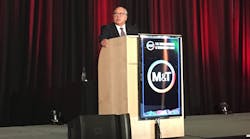Cleveland-Cliffs CEO: ‘Manufacturing Can Be Profitable, Steelmaking Can Be Profitable’
It’s impossible to miss the growth trajectory of Cleveland-Cliffs Inc. Since December 2019, the iron ore and steel producer has bought up AK Steel and most of ArcelorMittal USA, started operations at a new plant in Toledo, Ohio, and just last month announced it would enter the scrap and recycling business with the acquisition of Detroit-based Ferrous Processing and Trading Co., which operates 22 scrap processing facilities, primarily in the Midwest.
Not surprisingly, annual revenue growth for Cleveland-Cliffs, the largest flat-rolled steel producer in North America, has been positively stratospheric. In fact, “tech-like” is how Cleveland-Cliffs CEO Lourenco Goncalves described company growth last week in Cleveland, where he presented a keynote address during the annual Manufacturing & Technology Show. He pointed to company revenues that have leaped from $2 billion in 2019 to $5 billion in 2020 to an estimated $21 billion for 2021 to support his description.
“But it’s not like tech in terms of profitability, because we actually make money,” he added, eliciting chuckles from the audience. Indeed, the company’s quarterly revenues have increased for six straight quarters. And the 2021 third-quarter results, released in October, showcased record quarterly revenue of $6 billion and record net income of $1.3 billion, “proving that manufacturing can be profitable, steelmaking can be profitable,” Goncalves said.
Moreover, he said, it generates “good-paying, middle-class” jobs, citing median employee compensation of nearly $102,000 at Cleveland-Cliffs. “We have 25,547 employees as of this morning; we are in a growing mode, we are hiring. More than 20,000 employees are represented by unions,” Goncalves said.
Environmental and Sustainability Commitments
Cleveland-Cliffs is placing big bets on U.S. manufacturing. Goncalves’ keynote address largely outlined moves his company is undertaking to improve its own competitiveness--as well as dispel what he clearly sees as misperceptions about U.S. manufacturing.
Among the topics he hit hard was the environment. The steelmaker has aggressive goals for reducing emissions from greenhouse gases, including a 25% reduction by 2030 from 2017 levels.
“We don't have a plan for 2050 like other companies do. We have a plan for 2022, another for 2023, 2024 all the way to 2030. Because this is as far as you can go without sounding ridiculous,” Goncalves said. Think about it, he said: 30-year commitments made back in 1991 could not have factored in many of the advances made in the intervening years – such as flip phones or the internet, for example – because they simply didn’t exist or weren’t yet public.
Nevertheless, “we are fully committed to reducing our greenhouse gas emissions,” the CEO said. He described the company’s blast furnaces as the “lowest CO2-intensive” in the industry and highlighted the use of natural gas to fuel production in the company’s new direct reduction plant in Toledo.
“We put a billion dollars in this [Toledo] plant when my company was making $2 billion in revenue,” Goncalves said. “Talk about betting the farm.”
And with the addition of a scrap recycling business to the Cleveland-Cliffs mix, “we are basically reducing the need to use carbon and reducing the generation of CO2,” Goncalves said.
The steelmaker also took aim at China’s steel industry, identifying it as the primary culprit behind steel CO2 emissions—not simply because they produce more steel, but because they produce steel using processes that pollute significantly more. China's share of global steel CO2 emissions surpasses the collective steel emissions from the rest of the world, Goncalves said.
“So, if CO2 is a proxy for global warming, and I believe it is, the problem is not in the United States,” Goncalves said. “We are not the problem. The problem is in China.”
Electric Vehicles and Infrastructure
Still, steel is “inevitable if America wants to be greener,” Goncalves said, and turned the conversation toward electric vehicles and infrastructure. The Cleveland-Cliffs CEO says his company is the largest supplier of steel to the U.S. automotive industry and has the ideal tools—namely advanced high strength steel and electrical steel—to be the primary player as the auto industry transitions to electric vehicles.
“We are working with not only the new names like Tesla, like Rivian … but also the old names like Ford, General Motors, Stellantis, Toyota, Honda, Volvo, Volkswagen,” Goncalves said.
He noted that President Biden set a goal that 50% of new passenger vehicle sales in the U.S. be EVs by 2030. “That’s a very aggressive goal. We’re right there with him.”
Sticking with the electric theme, Goncalves pointed out the opportunity for U.S. steel producers in the infrastructure bill. There’s not only $7.5 billion set aside to build a national network of plug-in electric vehicle chargers, but also $65 billion assigned to modernize the electric grid.
“And that will be done with steel from Cleveland-Cliffs,” the company CEO said.





